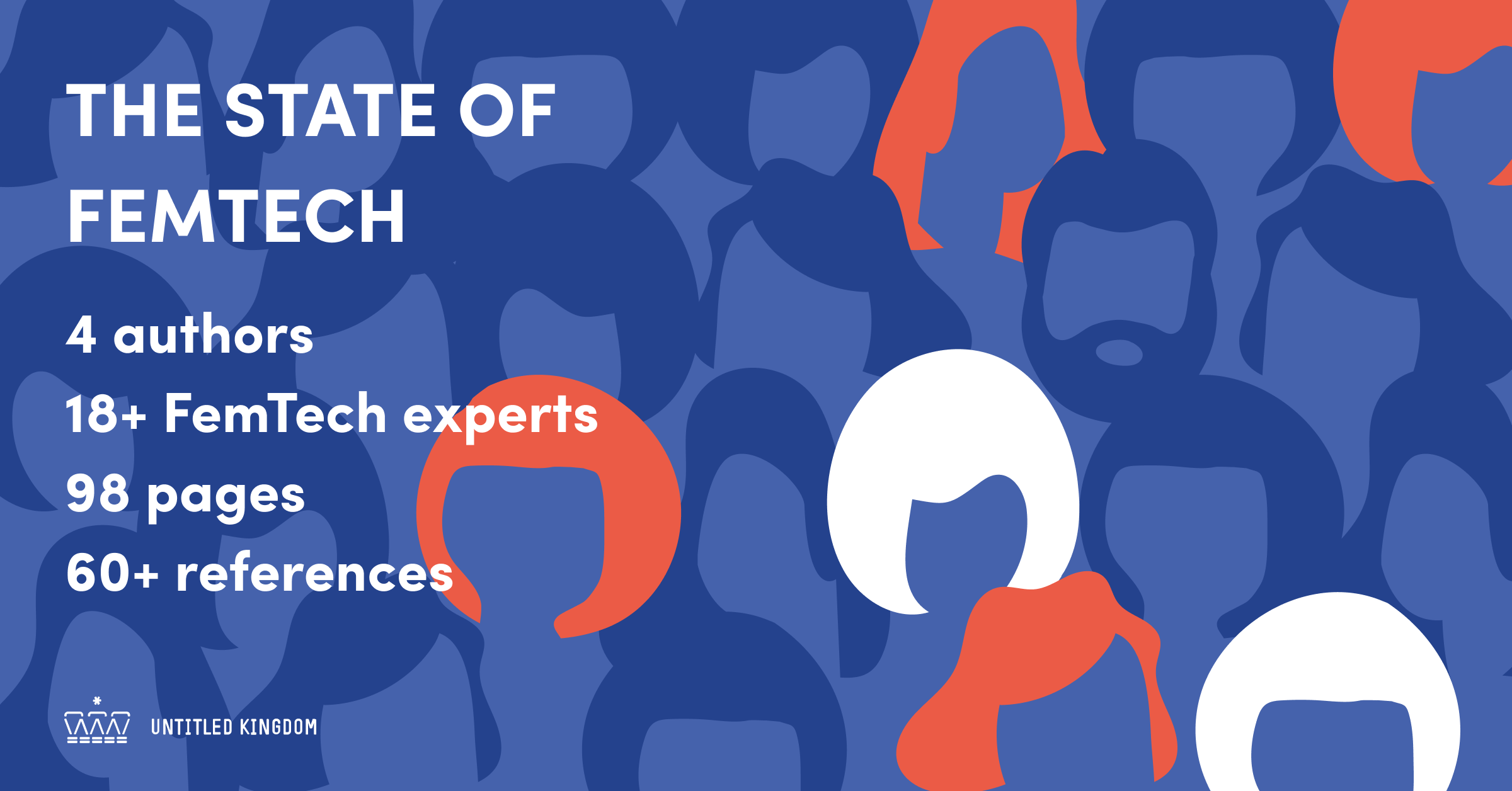
FemTech wavesWhere are we? Where are we going?

Until FemTech distinguished itself as a separate category from digital health, market solutions focused theoretically on the problems of all. Still, as experience has shown, men's health issues have been mainly addressed. This is evidenced by the fact that the first full and anatomically correct clitoris drawing was made in 1998.
In this article I would like to compare all FemTech waves and show which sectors have the greatest chances for development in the coming years.
Table of contents:
Three waves of FemTech
In the first wave of solutions for women, startups focused on areas that clearly distinguish women from men in terms of physiology and reached young people using modern technology. At the very beginning, these were applications and devices related to menstrual health, fertility tracking, pregnancy, and breastfeeding, which were to violate the taboo as little as possible.
Then there were solutions for women who fought against common female diseases, and for such things as pelvic and uterine care. Only in the next wave of FemTech, along with the growing awareness of users and increasing medical knowledge, solutions focused on improving the mental and sexual health of women began to appear, as well as their general wellness, nutrition, or fitness.
Recently, SexTech aimed at women has been a broader topic for discussion, as has menopause. We anticipate that this will be the most influential trend in coming years, associated with fewer taboos and the fact that more older people use technological solutions.
Why is it profitable to invest and develop FemTech products and services? Research shows that 66% of female internet users look online for healthcare information. Besides, women are 75% more likely to use digital tools for healthcare than men.
Pelvic and uterine care and wellness
.png?width=157&name=Group%20(13).png)
Pelvic problems are widespread in women. The pelvic floor muscles can become weakened, damaged by surgery, pregnancy, and childbirth. Symptoms of pelvic floor problems include:
urinary incontinence,
fecal incontinence,
constipation,
pain in lower abdomen or vagina,
tailbone pain,
problems or pain with sexual intercourse.
Treatment may include:
pelvic floor muscle strengthening or relaxation exercises,
biofeedback therapy,
manual therapy,
education and a home exercise program.
There are many apps available that help exercise the pelvic floor muscles, including one from the National Health Service in the UK, but they are mainly used as a source of information and reminders. The most beneficial is the connection of an application with a device that exercises with the user, such as an Elvie Trainer. If digital products are not taken into account, there are many offline solutions on the market that help women exercise the pelvic floor, such as kegel balls, vaginal cones, vagina gyms or digital biofeedback vaginal exercisers.
Read more in “The State of FemTech”
Menstrual health, period tracking and birth control
With a market flooded with period tracking apps and devices, it’s now much more comfortable for women to track their menstrual cycle. They help to track non-fertile and ovulation days, minimize the risk of unwanted pregnancy, and also help women plan their pregnancy. Some of them also track other health categories, such as body temperature, exercise, pain, sleep, and emotions.
The apps can detect pre-menopausal syndrome or menstrual cycle disorders. They can also explain how birth control pills or emergency contraceptive pills impact fertility, and include a reminder feature for taking medicines. One of the significant and widespread applications in this segment is Clue, founded by Ida Tin. It is integrated with Apple’s HealthKit and allows data such as menstruation, body temperature, sexual activity, and spotting to be synced directly to the app.
An insight on birth control from Aagya Mathur: “Roughly half of humankind is female and in the US most go through a phase in life when they are actively trying to avoid getting pregnant. The Pill is twice as popular as any other form of contraception in the US, yet over 1M women in the US have unintended pregnancies each year from inconsistent use of the Pill. The Pill has to be taken every day at the same time for it to be effective, but we live in a fast paced world with numerous distractions, and we heard from many women that the Pill experience was stressful, a nightmare, or always on their mind. Nothing out there was automatic, so we set out to solve that!”.
Similar companies create products such as a wristband to monitor women's monthly cycles. The tracker collects data on sleep, breathing, and blood flow. These are important factors that inform women about their most fertile days in a month, which increases the chances of becoming pregnant.
One concern about menstrual tracking apps is that the majority of them, especially those available for free, are ineffective. Out of 1,116 free period apps in Apple’s App Store, only 20 were accurate, out of which only 5% cited involvement with medical science, according to a study conducted by Columbia University Medical Center. Most apps did not provide measured evidence-based interventions or valuable information, further cutting the chord of scientific research required to better inform and educate the user on their most fertile days.
An outstanding story from Nick Chang: "I used to work in family planning clinics throughout the Bay Area and saw first-hand the consequences of limited access to reproductive healthcare and the social barriers patients experienced. I was also surprised at how antiquated the system was - both the medical and pharmacy sides of healthcare were (and still are) problematic, disjointed and difficult to navigate.
My experience working in these clinics inspired me to found Pill Club in 2014. Our mission is to help women take control of their own healthcare by providing access to birth control and education in communities around the country. In having our own pharmacy and using technology, we’ve brought personalized reproductive care to members in all 50 states, and provide a seamless experience for obtaining birth control. We also help our members navigate the complicated world of insurance, prescribing medication and delivering for free".
Pregnancy and nursing care
.png?width=150&name=Group%20(14).png)
FemTech can assist women from pre-pregnancy, through pregnancy to the post-pregnancy stage. There are apps that guide women on their fertility, and also give postnatal care. They count days and weeks, and inform women weekly on the size of their baby. They give advice on their changing bodies, and even suggest pain or stress relief procedures during rough days.
Apps and wearable trackers can monitor body changes during the whole pregnancy. Data collected in the app presents a broader knowledge about health conditions to doctors.
There are solutions on the market that help with newborn baby health monitoring, and nursing care. Women can easily use feeding time reminders, book a doctor's appointment and much more.
Devices such as Elvie Pumps help women with breastfeeding. It's the world's first silent wearable breast pump, which allows mothers to pump wherever they are: at home, in the car, at work, or on a walk. The global breast pumps market size alone was valued at USD 1.8 billion in 2018 and is expected to expand at a CAGR of 7.8% over the forecast period.
FemTech also helps women who are unable to conceive naturally or had a rough experience in an earlier pregnancy. Some companies offer IVF, egg freezing, and other treatments.
Prenatal screening
The risk of genetic conditions such as Down syndrome can be assessed by prenatal screening. Even though the number of tests is growing, the lack of a patient's knowledge about non-invasive prenatal testing is still a reality. How could decision-making about testing be facilitated by mobile technology?
NIPT Insights mobile app is an educational tool that gives information about testing and screening for the common chromosomal conditions (e.g. Down syndrome). It is especially helpful for women considering non-invasive prenatal testing. The specific information related to screening options in countries is now available in the United Kingdom, Spain, and France, but anyone can download the app.
Also, medical institutions such as hospitals and clinics have started to use technology for collecting and analyzing data, or making evidence-based decisions. The Genetic Sonography App was created strictly for Fetal-Medicine specialists. All calculations are used according to a hospital or clinic’s protocols for Prenatal Diagnosis.
The UCSF Fetal Treatment Center app contains information specifically for referring physicians and their patients. It includes treatment guidelines for the conditions the Fetal Treatment Center treats, clinical trial information, educational videos, and news from the center.
General wellness, nutrition and fitness
Self care is caring about your physical and psychological side. There are plenty of apps focusing on fitness, exercise, nutrition and food. Many of them, if not most, target women, who are the primary healthcare decision-makers. They make 80% of all buying and usage decisions.
Women generally pay more attention to health, and they're more aware of health issues. That makes females a leading group utilizing health tech novelties.
What about the usage of wellness apps? 96% of users are loyal to only one health and fitness app. Over 75% of active users open their health and fitness app at least two times a week, and more than 25% of users access their fitness apps more than ten times a week.
Mental health
.png?width=143&name=Group%20(15).png)
Good mental health is essential to overall well-being. More than one in five women in the United States experienced a mental health condition in the past year, such as depression or anxiety.
The same numbers of women and men experience mental health problems overall, but some issues are more common in women than men, and vice versa. Various social factors put women at higher risk of poor mental health than men. However, women's readiness to talk about their feelings and their secure social networks can help protect their mental health.
What are the most interesting worldwide statistics on women's health?
Depressive disorders account for close to 41.9% of the disabilities of neuropsychiatric disorders among women, compared to 29.3% among men.
The leading mental health problems of older adults, of which women are the majority, are depression, organic brain syndromes and dementias.
An estimated 80% of the 50 million people affected by violent conflicts, civil wars, disasters, and displacement are women and children.
The lifetime prevalence rate of violence against women ranges from 16-50%.
At least one in five women suffer rape or attempted rape in their lifetime.
What we should focus on to prevent mental illness and support women:
Build evidence on the prevalence and causes of mental health problems in women, as well as on the mediating and protective factors.
Promote the formulation and implementation of health policies that address women's needs and concerns from childhood to old age.
Enhance the competence of primary healthcare providers to recognize and treat the mental health consequences of domestic violence, sexual abuse, and acute and chronic stress in women.
In recent years, there’s been a proliferation of mental health apps available to smartphone users, which address depression, eating disorder recovery, anxiety, PTSD, obsessive-compulsive disorder, and more.
The majority of apps do not have peer-reviewed research to support their claims, even though experts predict that innovative mobile apps solutions for mental health disorders will play a significant role in mental health care in the future.
Read more in “The State of FemTech”
Sexual wellness
FemTech companies have started building devices for sexual wellness. Women have begun to talk about their needs more and more confidently and openly. The FemTech market provides many women-focused solutions, which are slowly coming out from the shadows, starting to appear at the most influential tech conferences, and are gaining more attention.
As Patricia Cervantez said: “Entering SexTech, we’ve had to do a lot of explaining on why sex toys matter, and how our sexual well-being not only impacts our mental health but our physical health as well. There are still misconceptions around female pleasure. Sadly, being two young women in the SexTech industry also means we’ve also had our share of unprofessional advances we’ve had to navigate”.
On the market, there are app-controlled vibrators and kegel trainers that can improve sexual experience. FemTech promises to have women’s backs through every stage of life, across borders, languages, and cultures. However, there's still a long way to go towards that goal.
Women think, feel and expose emotions differently
.png?width=159&name=Group%20(16).png)
The differences in reproductive organs are apparent. But it's not the only thing. Sexual dimorphism is the scientific term for physical differences between males and females of a species. Let's take the chest. Women have breasts, whereas men have flat chests.
80% of women wear a poorly fitting bra. Wearing the wrong size bra is not only uncomfortable, but it can also affect our health. 50% of women reported breast pain, which is frequently caused by a lack of breast support.
An ill-fitting bra can also lead to skin damage, neck, back and shoulder pain, and permanent changes in posture. Generally, women are more delicate than men. For example, they have smaller hands, so having the latest iPhone is not the most comfortable experience.
As Ann Garnier said: “There is still so much we don't know about women's bodies. For example, auto-immune conditions predominantly affect women. The same for dementia. Why is that? We should be looking more deeply into these areas and figuring out how to solve them”.
There are also many differences in how women think, feel, expose their emotions, and how they dress. Women's versions of the same jacket model often have no pockets, whereas the men’s version has plenty. Maybe it's because many women carry a bag. But when hiking, it's better for a woman to leave her purse at home. Where is a place for her phone then?
Nothing is more important than health, and the interest that technology companies are giving health is significant, and necessary. We have given only a few examples that show there are more unanswered women's needs, which hopefully will get more prominent attention in the future.
Read more about FemTech:
Why do we distinguish FemTech products from other tech products?
[Video] Digital transformation of women's products
[Video] Improving FemTech. Optimize your product to women's needs
.png?width=157&name=Group%20(12).png)

